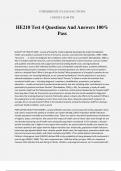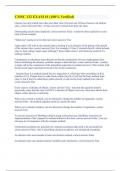©THEBRIGHT EXAM SOLUTIONS
11/8/2024 12:08 PM
HE210 Test 4 Questions And Answers 100%
Pass
QUALITY OF HEALTH CARE - answer✔Using the model originally developed by Avedis Donabedian,
health care quality is assessed in terms of structure, process, and outcomes (Donabedian, 1980- 1985).
"Structure . . . is meant to designate the conditions under which care is provided" (Donabedian, 2003, p.
46). It includes material resources, such as facilities and equipment; human resources, such as number
and qualities of professional and support personnel providing health care; and organizational
characteristics, such as (for individual facilities such as hospitals) nonprofit status, academic affiliation,
and governing structure. Examples of structure-oriented questions are: What is the nurse-to-patient
ratio on a hospital floor? What is the age of the facility? What proportion of a hospital's patients do not
have insurance, are receiving Medicaid, or are covered by Medicare? Are the physicians in a practice
salaried employees or paid on a fee-for-service basis? Process "is taken to mean the activities that
constitute health care— including diagnosis, treatment, rehabilitation, prevention, and patient
education— usually carried out by professional personnel, but also including other contributions to care,
particularly by patients and their families" (Donabedian, 2003, p. 46). For example, a study of health
care process might ask the following questions: Is infection control policy followed by the hospital staff?
How long does it take for the primary care physician to receive the test results needed for diagnosis?
How does the treating physician transmit information about a drug's side effects to the patient? What is
the waiting time in the emergency room? How much time does a physician spend with a patient, on
average, for an annual physical? What is the standard practice among the physician staff for treating a
particular health condition, such as acute
POPULATION HEALTH OUTCOMES - answer✔Health outcomes can be measured at the population level
and used to evaluate the quality of a health care system (Kindig, 1997). Population health indicators
include population mortality and morbidity rates. These are used in macrolevel performance evaluations
of regions, states, and nations. We assume the impact of health care on these rates even though we are
not directly measuring use of health care among the population considered. If, for example, a disease-
specific mortality rate is higher in one region than another, we assume that the health care system has
not been optimal in the region with the higher mortality rate. Historically, population health indicators
have been age-adjusted death rates, disease-specific death rates, life expectancy, premature death rate,
time lost to prema ture death, and infant mortality rate (IMR). 1 The United Nations International
Children's Emergency Fund (UNICEF) defines IMR as the probability of dying between birth and exactly 1
year of age (UNICEF, 2006). This rate is expressed per 1,000 live births per year. IMR is an important
measure that indicates the well-being of infants, children, and pregnant women, as it is associated with
, ©THEBRIGHT EXAM SOLUTIONS
11/8/2024 12:08 PM
maternal health, quality, and access to care, and public health in a given population. Life expectancy is
defined by the World Health Organization (WHO) as the number of years of life that can be expected, on
average, in a given population. Using life expectancy, the premature death rate can be calculated. The
premature death rate is the death rate for persons who die before the expected age of death for that
population. The time lost to premature death, also called years of potential life lost (YPLL), is based on
the difference between the actual age at death and the expected age at death. Deaths at a younger age
are weighted more heavily in the YPLL
CLINICAL OUTCOMES - answer✔Health outcomes that are specific to the persons who receive care are
often called clinical outcomes . We frequently use the following outcome measures in studies of health
care quality among patients: readmission to the hospital after a surgical procedure; functional capacity
after medical intervention; long-term pain and discomfort after medical treatment; infection acquired
during a hospital stay (nosocomial); 5-year mortality rates among patients treated for cancer, heart
disease, or other diseases; development of comorbidities after medical therapy; and satisfaction of the
patient with the outcomes of health care treatment. Clinical outcomes research is the term given to
studies that focus on the persons who receive care (patients) and the outcomes of their treatment.
Following is a discussion of health care quality at the microlevel of clinical outcomes. We examine two
aspects related to microlevel evaluation of health care quality: clinical effectiveness and patient safety.
CLINICAL EFFECTIVENESS - answer✔A major concept used in defining the quality of health care in the
present era is the evaluation of its effectiveness , that is, whether the care produces the desired or
intended result. This term is synonymous with efficacy . Assessing the effectiveness, or efficacy, of
health care at the microlevel of physician practices, hospitals, and other health care settings is becoming
increasingly evidence based, that is, based on scientifically valid, empirical research. One of the best and
most well-known definitions of evidence-based medicine is from an article in the British Medical Journal
(Sackett, Rosenberg, Gray, Haynes, & Richardson, 1996): Evidence-based medicine is the conscientious,
explicit, and judicious use of current best evidence in making decisions about the care of individual
patients. The practice of evidence-based medicine means integrating individual clinical expertise with
the best available external clinical evidence from systematic research. (p. 71) Thus, the standards
against which quality is measured are based on clinical research. Clinical outcomes research is the
foundation of quality-improvement efforts at the microlevel. Beginning in the last decade of the 20th
century, and funded by the Agency for Healthcare Research and Quality (AHRQ), the Centers for Disease
Control and Prevention (CDC), the National Institutes of Health (NIH), and other organizations,
researchers have continually generated, updated, and published the results of clinical outcomes studies.
These studies have then been synthesized by experts in the field, and the synthesized results are
translated into clinical practice guidelines (or alternatively, clinical practice protocols). A standard
definition of clinical practice guidelines was developed by Field and Lohr (1992): "systematically
developed statements to assist practitione
PATEINT SAFETY - answer✔Another aspect of health care quality is patient safety. The patient safety
movement of the 1990s led to a great deal of interest in improving the quality of health care delivery
through the application of methods borrowed from other industries and pioneered by W. Edwards
Deming. Deming was an American statistician, considered the father of the modern quality assurance
, ©THEBRIGHT EXAM SOLUTIONS
11/8/2024 12:08 PM
movement. He developed his system following the end of World War II. Unable to get a hearing in this
country, he went to Japan. His methods, designated Statistical Process Control (SPC) and Total Quality
Management (TQM), strongly influenced the rebirth and eventual massive expansion of Japanese
industry post- World War II. Patient safety has been defined by the Institute of Medicine (2000) as
"freedom from accidental injury; ensuring patient safety involves the establishment of operational
systems and processes that minimize the likelihood of errors and maximizes the likelihood of
intercepting them when they occur" (p. 211). Therefore, patient safety encompasses all events and
situations that result in accidental harm to patients, including medication errors, surgical mistakes, falls,
improper use of medical devices, and nosocomial infection. The Institute of Medicine report, To Err Is
Human (2000), has played a major role in bringing national attention to the issue of patient safety. The
Report converted an issue of gradually growing professional awareness over a great deal of time to one
of substantial public concern in a manner and pace unprecedented in modern experience with matters
of healthcare quality. The epidemiologic finding that more than one million injuries and nearly 100,000
deaths occur in the United States annually as a result of mistakes in medical care came from studies
nearly a decade old. But this was new information for the public,
ORGANIZATIONS WITH MAJOR INFLUENCE ON HEALTH CARE QUALITY - answer✔The following section
describes the efforts of public and private organizations to improve the quality of health care in the
United States. These efforts are increasingly collaborative. Many businesses that pay for the health care
of their employees have banded together. Public initiatives are increasingly coordinated. And, private-
public partnerships have developed. However, it is difficult to say which organizations are the most
influential. Clearly, The Joint Commission and the Centers for Medicare & Medicaid Services (CMS), as
one of the largest payers of health care services in the country, are extremely influential. However,
private organizations and other public agencies have very important roles, as well. The impact of these
significant efforts on the quality of U.S. health care is yet to be determined.
THE JOINT COMMISSION AND OTHER HEALTH CARE ACCREDITING ORGANIZATIONS - answer✔Though
they are private entities, the accrediting organizations have a great deal of direct and indirect influence
on quality assurance and improvement in health care. This is particularly true because of the
relationship between the CMS certification process and accreditation by a CMS-approved accrediting
organization: In order for a healthcare organization to participate in and receive payment from the
Medicare or Medicaid programs, it must be certified as complying with the Conditions of Participation
(CoP), or standards, set forth in federal regulations. This certification is based on a survey conducted by
a state agency on behalf of the Centers for Medicare & Medicaid Services (CMS). However, if a national
accrediting organization, such as The Joint Commission, has and enforces standards that meet the
federal Conditions of Participation, CMS may grant the accrediting organization "deeming" authority and
"deem" each accredited health care organization as meeting the Medicare and Medicaid certification
requirements. The healthcare organization would have "deemed status" and would not be subject to
the Medicare survey and certification process. (American Society for Healthcare Engineering [ASHE],
2012, p. 1) The CoPs and Conditions for Coverage (CfCs) set by CMS are standards that CMS considers
essential for improving quality and protecting the health and safety of Medicare and Medicaid
beneficiaries. Through its approval process, CMS tries to ensure that the standards of approved





